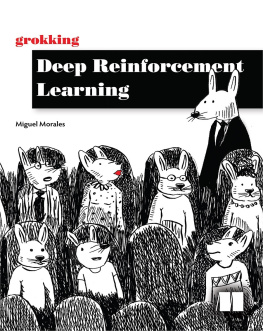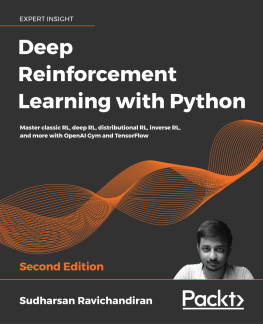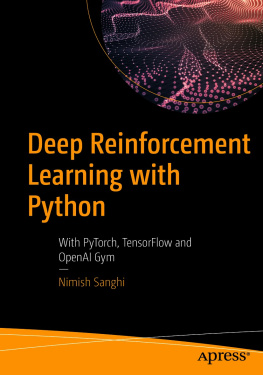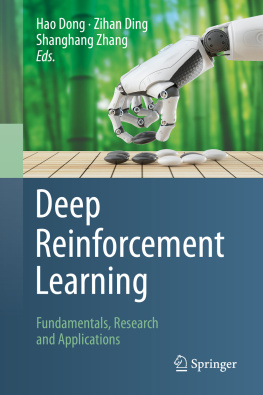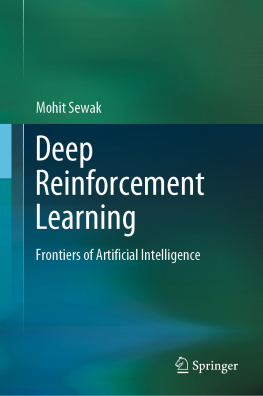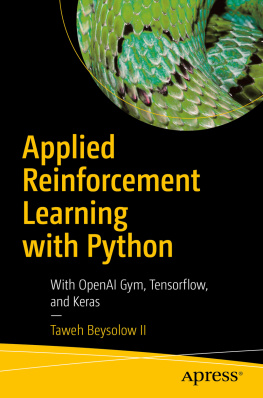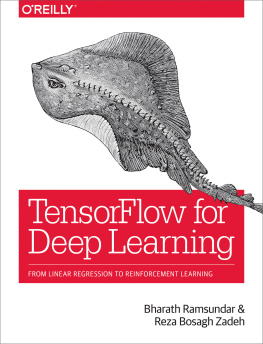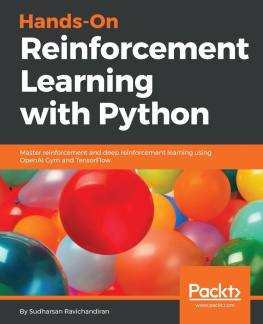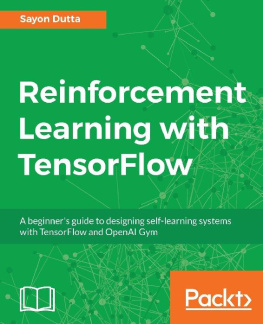
Grokking Deep Reinforcement Learning
Miguel Morales
Foreword by Charles Isbell, Jr.
To comment go to liveBook

Manning
Shelter Island
For more information on this and other Manning titles go to
manning.com
Copyright
For online information and ordering of these and other Manning books, please visit manning.com. The publisher offers discounts on these books when ordered in quantity.
For more information, please contact
Special Sales Department
Manning Publications Co.
20 Baldwin Road
PO Box 761
Shelter Island, NY 11964
Email: orders@manning.com
2020 by Manning Publications Co. All rights reserved.
No part of this publication may be reproduced, stored in a retrieval system, or transmitted, in any form or by means electronic, mechanical, photocopying, or otherwise, without prior written permission of the publisher.
Many of the designations used by manufacturers and sellers to distinguish their products are claimed as trademarks. Where those designations appear in the book, and Manning Publications was aware of a trademark claim, the designations have been printed in initial caps or all caps.
Recognizing the importance of preserving what has been written, it is Mannings policy to have the books we publish printed on acid-free paper, and we exert our best efforts to that end. Recognizing also our responsibility to conserve the resources of our planet, Manning books are printed on paper that is at least 15 percent recycled and processed without the use of elemental chlorine.

| Manning Publications Co. 20 Baldwin Road Technical PO Box 761 Shelter Island, NY 11964 |
Development editor: | Jenny Stout |
Technical development editor: | Al Krinker |
Review editor: | Ivan Martinovi |
Production editor: | Lori Weidert |
Copy editor: | Katie Petito |
Proofreader: | Katie Tenant |
Technical proofreader: | Mayur Patil |
Typesetter: | Jennifer Houle |
Cover designer: | Leslie Haimes |
ISBN: 9781617295454
dedication
For Danelle, Aurora, Solomon, and those to come.
Being with you is a +1 per timestep.
(You can safely assume +1 is the highest reward.)
I love you!
This book was originally downloaded from sanet.st.

front matter
foreword
So, heres the thing about reinforcement learning. It is difficult to learn and difficult to teach, for a number of reasons. First, its quite a technical topic. There is a great deal of math and theory behind it. Conveying the right amount of background without drowning in it is a challenge in and of itself.
Second, reinforcement learning encourages a conceptual error. RL is both a way of thinking about decision-making problems and a set of tools for solving those problem. By a way of thinking, I mean that RL provides a framework for making decisions: it discusses states and reinforcement signals, among other details. When I say a set of tools, I mean that when we discuss RL, we find ourselves using terms like Markov decision processes and Bellman updates. It is remarkably easy to confuse the way of thinking with the mathematical tools we use in response to that way of thinking.
Finally, RL is implementable in a wide variety of ways. Because RL is a way of thinking, we can discuss it by trying to realize the framework in a very abstract way, or ground it in code, or, for that matter, in neurons. The substrate one decides to use makes these two difficulties even more challengingwhich bring us to deep reinforcement learning.
Focusing on deep reinforcement learning nicely compounds all these problems at once. There is background on RL, and background on deep neural networks. Both are separately worthy of study and have developed in completely different ways. Working out how to explain both in the context of developing tools is no easy task. Also, do not forget that understanding RL requires understanding not only the tools and their realization in deep networks, but also understanding the way of thinking about RL; otherwise, you cannot generalize beyond the examples you study directly. Again, teaching RL is hard, and there are so many ways for teaching deep RL to go wrongwhich brings us to Miguel Morales and this book.
This book is very well put together. It explains in technical but clear language what machine learning is, what deep learning is, and what reinforcement learning is. It allows the reader to understand the larger context of where the field is and what you can do with the techniques of deep RL, but also the way of thinking that ML, RL, and deep RL present. It is clear and concise. Thus, it works as both a learning guide and as a reference, and, at least for me, as a source of some inspiration.
I am not surprised by any of this. Ive known Miguel for quite a few years now. He went from taking machine learning courses to teaching them. He has been the lead teaching assistant on my Reinforcement Learning and Decision Making course for the Online Masters of Science at Georgia Tech for more semesters than I can count. Hes reached thousands of students during that time. Ive watched him grow as a practitioner, a researcher, and an educator. He has helped to make the RL course at GT better than it started out, and continues even as I write this to make the experience of grokking reinforcement learning a deeper one for the students. He is a natural teacher.
This text reflects his talent. I am happy to be able to work with him, and Im happy hes been moved to write this book. Enjoy. I think youll learn a lot. I learned a few things myself.
Charles Isbell, Jr.
Professor and John P. Imlay Jr. Dean
College of Computing
Georgia Institute of Technology
preface
Reinforcement learning is an exciting field with the potential to make a profound impact on the history of humankind. Several technologies have influenced the history of our world and changed the course of humankind, from fire, to the wheel, to electricity, to the internet. Each technological discovery propels the next discovery in a compounding way. Without electricity, the personal computer wouldnt exist; without it, the internet wouldnt exist; without it, search engines wouldnt exist.
To me, the most exciting aspect of RL and artificial intelligence, in general, is not so much to merely have other intelligent entities next to us, which is pretty exciting, but instead, what comes after that. I believe reinforcement learning, being a robust framework for optimizing specific tasks autonomously, has the potential to change the world. In addition to task automation, the creation of intelligent machines may drive the understanding of human intelligence to places we have never been before. Arguably, if you can know with certainty how to find optimal decisions for every problem, you likely understand the algorithm that finds those optimal decisions. I have a feeling that by creating intelligent entities, humans can become more intelligent beings.

